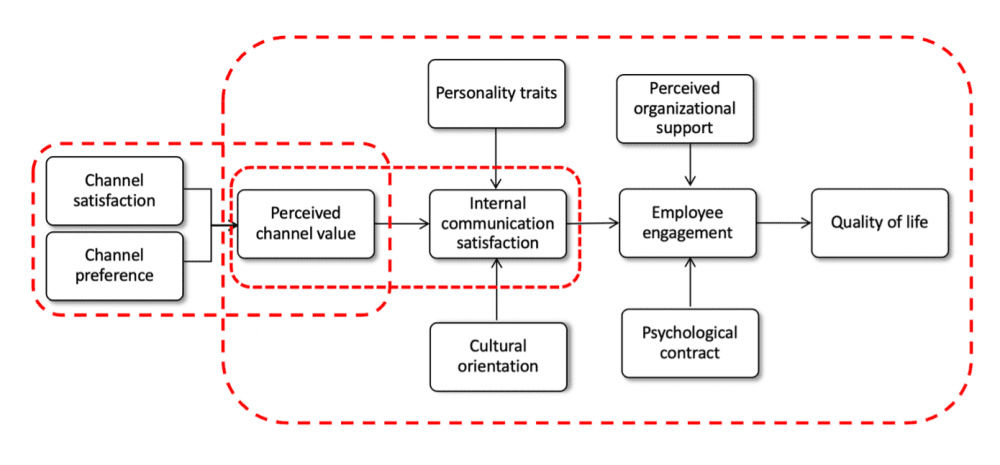
This blog is provided by the IPR Organizational Communication Research Center
Formal organizations are considered the central institutions of modern society. We exist with and through them as they organize and structure our life from the beginning through to the end. New technology has created different challenges for all types of organizations. On the one side we witness progress and an increase in life satisfaction, while on the other we see disruption and possible risks. Post-pandemic working patterns are going to accelerate many pre-existing trends. The average employee wants to work from home almost half the time, while employers do not share this approach. This overlapping of home and office already has and will continue to have vast consequences. It will lead to changes in all aspects of work and create bigger divides. It will also bring improvement, as managers will have to communicate better and stop expecting employees to pick up information by osmosis. To understand new patterns of communication and how they affect employees’ lives, a group of Croatian and Slovenian communication scientists is developing a theory of internal communication preference. The aim is to explore how digitalisation, culture, personality, engagement, and life satisfaction are connected. The project will answer the following questions:
— How does digitalization affect internal communication, engagement, and life satisfaction?
— How do culture and personality determine internal communication preferences?
— How do we design optimal internal communication systems in a new digital society?
Within the project we will try to create a comprehensive framework for assessing internal communication across diverse contexts. It will integrate concepts from various theoretical backgrounds, establishing relationships among them and unifying these ideas within a new theoretical framework. The main key concepts are listed below.
Key concepts
The project emphasizes the growing importance of internal communication as a specialization in communication management. How employees perceive the organization directly impacts external stakeholders’ views. Shifts in the organizational environment necessitate a review of internal communication practices, especially from public relations and strategic communication perspectives. Internal communication satisfaction is crucial. Satisfied employees are more likely to stay with the organization. Understanding satisfaction is essential for comprehending communication behavior. It is a central variable influencing various aspects of working lives and life satisfaction, making it vital for organizational success.
Despite the rise in digital communication, adopting new technologies is complex. Satisfaction with internal communication channels depends on content, channels, personality, and situational factors. Organizations often have one-way approaches to communication, raising the need to assess if computer-mediated communication meets employees’ needs. Personality traits influence media preferences. The project uses the Big-Five framework to explore how specific traits impact internal communication preferences, acknowledging the diverse preferences for digital media among individuals. National cultural values also impact workplace attitudes and technology usage. Integrating cross-cultural communication research with media choice research, the project aims to understand how cultural dimensions form a framework for internal communication preferences in a European context. Internal communication is viewed as an initiating action affecting social exchange between the organization and employees. Psychological contract fulfillment and perceived organizational support act as mediating variables, exploring their role in connecting internal communication with engagement.
Effective internal communication fosters engaged employees, a significant competitive advantage for organizations. Two-way communication and efficient internal communication procedures enhance employees’ regard for their employers and engagement in organizational goals. Internal communication satisfaction directly relates to employees’ life satisfaction, a key component of subjective well-being. Strategic communication plays a role in creating an encouraging working environment, making it relevant to explore the theoretical and practical relationship between internal communication satisfaction and overall life satisfaction.
The research project underscores the intricate connections between internal communication, employee satisfaction, engagement, cultural factors, and overall life satisfaction. Understanding these dynamics is essential for organizations aiming to create positive work environments and foster employee well-being and productivity.

Figure 1. Internal communication preference theory
Practical implications
— Importance of internal communication: Organizations need to recognize the crucial role of internal communication. It’s not just about conveying information but also about ensuring employee satisfaction, engagement, and overall well-being. Understanding how internal communication preferences vary among employees is essential.
— Impact of digitalization: The digitalization of communication channels poses both challenges and opportunities. Organizations need to adapt to new technologies but also understand that the adoption of digital tools is complex. There is a need to align digital communication with employees’ needs and preferences.
— Role of personality and culture: Employee preferences for communication channels are influenced by their personality traits and cultural backgrounds. Organizations should consider these factors when designing internal communication strategies, especially in multinational settings.
— Employee satisfaction: Internal communication satisfaction directly affects various aspects of working lives and, consequently, life satisfaction. Organizations should invest in strategies and channels that enhance employee satisfaction, as this can lead to higher retention rates and a more positive work environment.
— Employee engagement: Effective internal communication is fundamental to employee engagement. Organizations should foster clear two-way communication and effective internal communication procedures to engage employees and align them with organizational goals.
— Strategic communication: Internal communication is not just a matter of information flow; it’s a strategic tool for creating an encouraging and inspirational working environment. It directly impacts employees’ subjective well-being and life satisfaction, which are critical for overall organizational success.
References
— Sinčić Ćorić, D., Pološki Vokić, N., & Tkalac Verčič, A. (2020). Does good internal communication enhance life satisfaction?. Journal of Communication Management, 24(4), 363-376.
— Tkalac Verčič, A., & Pološki Vokić, N. (2017). Engaging employees through internal communication. Public Relations Review, 43(5), 885-893;
— Tkalac Verčič, A., Galić, Z., & Žnidar, K. (2023). The relationship of internal communication satisfaction with employee engagement and employer attractiveness: testing the joint mediating effect of the social exchange quality indicators. International Journal of Business Communication, 60(4), 1313-1340.
— Tkalac Verčič, A., Sinčić Ćorić, D., & Pološki Vokić, N. (2021). Measuring internal communication satisfaction: validating the internal communication satisfaction questionnaire. Corporate Communications: An International Journal, 26(3), 589-604;

Ana Tkalac Verčič is a Professor of Marketing Communications and Public Relations at the University of Zagreb, Croatia. A former Fulbright scholar and recipient of the CIPR diploma, she has authored several books and published over 100 papers in academic journals. Recognized for her contributions, she has received numerous awards and served in editorial boards for prestigious journals.



